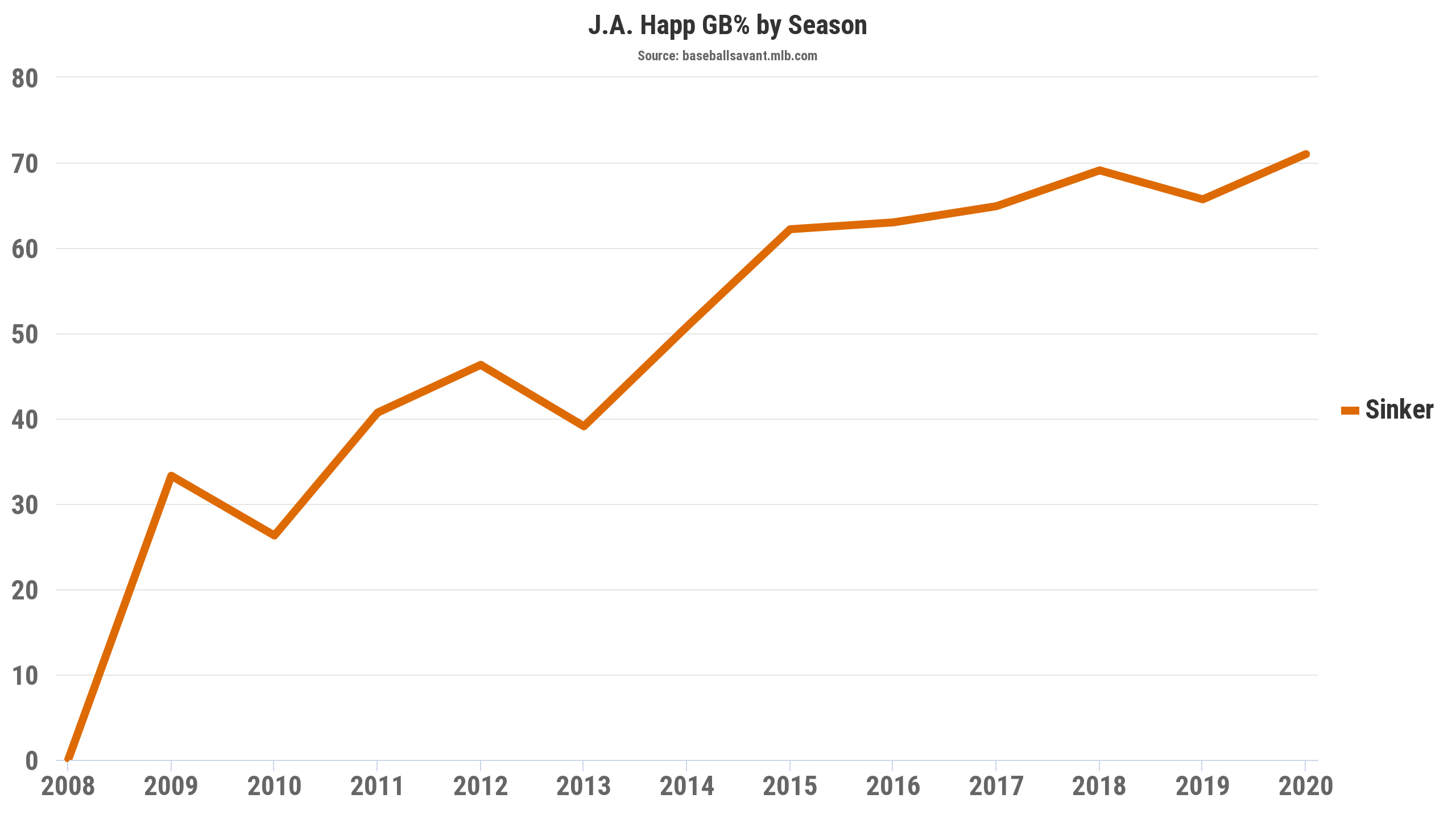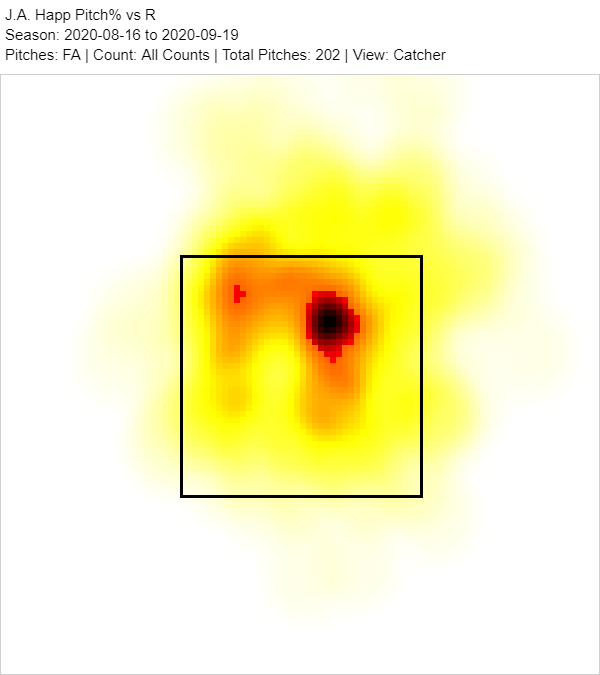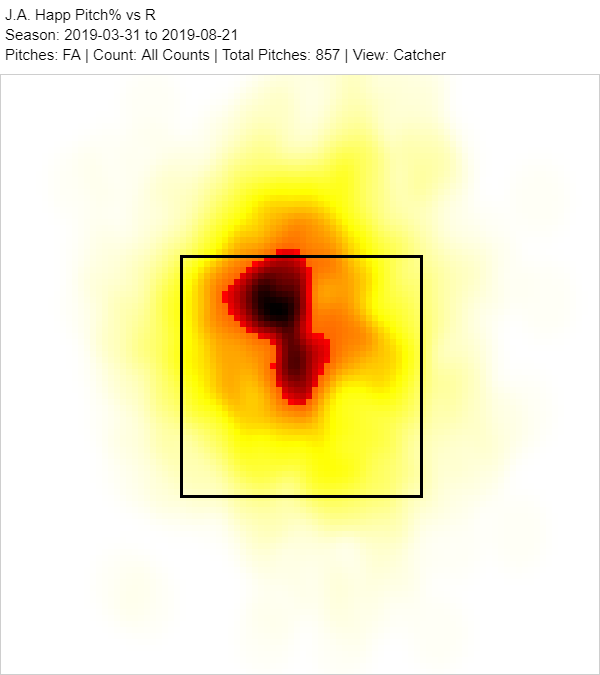It’s no surprise that J. A. Happ was not exactly many Yankees fans’ favorite player after a disastrous first full season in New York in 2019 with a 4.91 ERA, and especially so at the beginning of this season following his first two starts of the abbreviated 2020 season in which every game matters more than ever.
Yankee fans, brutal and sometimes irrational as they may be, were probably justified in this regard after those first two starts because they were, quite frankly, pretty disastrous. He went seven total innings and gave up four runs in each start. If you are keeping score at home, that’s a 10.29 ERA, and there were not any encouraging peripherals to back it up, with an even worse 11.32 FIP in those same two starts. A big part of those struggles were home runs, as Happ allowed three in that span and continued that worrying trend from a season ago, where he set new career-worsts in home runs per nine at 1.90 and home runs per fly ball at 18.3%, both of which were among the worst in the league in 2019.
The Yankees, with a run of COVID-19-related postponements, skipped Happ’s turn in the rotation a couple of times from that point on in order to get their more highly touted arms such as Gerrit Cole on the mound as much as possible. Happ had an 11-day layoff between starts from August 5th to August 16th, and then a 13-day layoff between starts after that, ending on August 29th. Happ had some things to say about that, believing the team to be manipulating his innings in order to avoid his $17 million option for 2021 from vesting. It’s an ugly situation all around, but it has been a big part of the discussion surrounding Happ’s season. To try and get away from that, the short of it is that Happ wasn’t pitching all that well at the start of the season, and ultimately the negative narratives surrounding his tenure as a Yankee were continuing.
It also doesn’t help things that, as a team, the Yankees were in freefall from late August or so through early September, which coincided with multiple injuries to their big offensive stars. A lot of the focus was on the Yankees anemic offense in that span, but in that span, Happ was actually going through quite the stretch and was one of the team’s biggest bright spots in that span.
Since those two disastrous opening starts to the season and going back to August 16th, Happ has a 1.93 ERA, 3.05 FIP, and 3.10 xFIP, and looks like a completely different pitcher on the mound—and one that is completely changing the narrative around himself this season. Even in that span, the focus has been placed more upon the Yankees top prospect Deivi García’s electric debut that has seen him acclimate well to the Majors as well as continuously solid outing-after-outing from Masahiro Tanaka and starts from Cole that have gotten better practically with each start. Happ is still perhaps being overlooked on his own team, while he has been maybe been their best starter in that span:
| Player | IP | ERA | FIP | xFIP | SIERA |
|---|---|---|---|---|---|
| J. A. Happ | 37.1 | 1.93 | 3.05 | 3.10 | 3.43 |
| Gerrit Cole | 43.2 | 2.89 | 4.01 | 3.25 | 3.14 |
| Masahiro Tanaka | 36.1 | 3.96 | 4.81 | 4.12 | 4.04 |
| Deivi García | 27.2 | 4.88 | 4.77 | 4.96 | 4.32 |
| Jordan Montgomery | 23.0 | 5.09 | 3.27 | 3.25 | 3.64 |
This is, admittedly, a cherry-picked time frame to work with and Cole is definitely the best pitcher in this table, but it does show that Happ has been quite good by a select few pitching metrics, which is quite a shock considering not only how he started this season, but also his preseason projections which viewed him more as the pitcher he was in 2019 than the one he has been this season.
How has Happ done this? Even during this hot run of form, it did not look too real at times. His SIERA was still high at 5.10 as recently as September 8th and coming off a tremendous start against the Blue Jays in which he struck out 10. We saw how well he’s been doing since August 16th though, so there must be something he’s doing that has made him look much better on the mound.
Throughout his career, Happ has developed a reputation for being a sinkerball pitcher. However, since 2018 (the season in which he was traded to the Yankees), the rate in which he’s thrown the pitch has been trending down. For context, he threw the pitch nearly 28% of the time in 2017 and threw it just 17.5% of the time in 2019 and as low as 14.1% in 2018. This season, it’s usage, while still down from previous career highs, has spiked to it’s highest rate since 2017, at 20.5%. This seems counterintuitive, considering the way pitching has trended in recent seasons. Ditch the sinker, they said. Indeed, Happ was following this trend in recent years, but it looks like he has reversed course this season. The difference this season is that Happ is using his sinker almost primarily against left-handed hitters, a switch from previous seasons:
| Season | Total Sinkers | LHH Sinkers | LHH Sinker % |
|---|---|---|---|
| 2017 | 693 | 123 | 17.7% |
| 2018 | 429 | 126 | 29.4% |
| 2019 | 471 | 226 | 48.0% |
| 2020 | 142 | 101 | 71.1% |
From this, despite nearly 100 fewer total innings in 2020 as compared to 2017 or 2018, Happ has thrown nearly as many sinkers to left-handed hitters this season than those two previous seasons. This switch appears to be working out well for Happ. Overall, the pitch is getting more groundballs than ever for him at 71%, up over six percent from 2017:
The gains are more noticeable when looking just at lefty hitters. Last season, Happ allowed just a 63% groundball rate to lefties on the pitch, the lowest such rate for him since 2014, but this season it is up nearly 10%, sitting at right around 72%. Additionally, the pitch overall is getting more whiffs and strikeouts this seasons than in the previous three seasons:
| Season | Whiff% | Strikeout% |
|---|---|---|
| 2017 | 11.2 | 7.3 |
| 2018 | 18.0 | 22.5 |
| 2019 | 18.2 | 13.6 |
| 2020 | 19.4 | 27.7 |
Happ is doing a good job of neutralizing lefty hitters this season. Not only is he getting more groundballs, but he is also getting more whiffs and strikeouts. While this is good to see, the sinker is just one aspect of Happ’s repertoire. Additionally, he is, as a left-handed pitcher, supposed to be better against same-handed hitters. That was the case for Happ last season, despite all the troubles overall, with a .280 wOBA allowed against left-handed hitters. A lot of the difference this season has come against right-handed hitters, a group that Happ struggled mightily against in 2019:
| Season | wOBA vs RHH |
|---|---|
| 2019 | 0.345 |
| 2020 | 0.301 |
Last season, Happ’s .345 wOBA allowed to right-handed hitters was the third-worst among lefty pitchers. This year, Happ has clearly been much better and moving up the ranks and has been top-15 in this regard, and since his two stinkers to start the season, he’s been in the top-10 at a .292 wOBA allowed mark to righties.
What has the difference been this season when it comes to facing righties? Well, we saw that Happ has been shying away from using his sinker against righties, which sounds like a good idea considering righties absolutely had their way with them in 2019 to the tune of a .531 slugging percentage and a .389 wOBA. Instead, Happ has gone back to the four-seam fastball heavy strategy. Against righties, he uses the pitch over 50%, with 85% of all of his four-seamers thrown this season being to righties. Now, this isn’t a new revelation for Happ, this has been a strategy he’s been using for the past few seasons. In fact, his four-seamer usage against righties is actually down this season and the lowest it’s been for Happ since 2017. The difference this season instead looks to be in location, with those differences in location being most notable in his more recent outings. Take, for instance, Happ’s four-seamer location to righties in his first two starts of the season:
Now, where that pitch has been located in outings since:
What immediately stands out is that in his first two starts of the season, Happ was locating that pitch nearly exclusively in the upper portion of the strike zone. This is another recent trend in baseball that Happ was following. Fastballs up in the zone are generally a good idea for pitchers considering how tough they are for hitters to hit. Like his increase in sinker usage, this change appears to be counterintuitive, but there does appear to be a method to Happ’s madness here. In his first two starts, right-handed hitters had a .272 batting average against, a .636 slugging percentage, a .364 isolated power mark, and a .467 wOBA against those primarily up in the zone fastballs. Since shifting to a more lower-in-the-zone and away approach, Happ has had a lot more success keeping right-handed hitters in check with fastballs with a much better .179 batting average against, .385 slugging percentage, .205 isolated power mark, and a .251 wOBA allowed, a night and day difference.
So what’s the catch here? It doesn’t seem right that Happ would be getting better results on his fastballs by going against the modern pitching trend, but the numbers are suggesting it. Well, in the case of Happ we may need to go back to last season to try and explain it.
One thing that was perhaps a little bit lost in Happ’s not great 2019 season was that he was actually quite good down the stretch. Starting in the final month of the 2019 season at around August 26th, Happ changed as a pitcher. From that point on, Happ pitched 32.1 innings and had a 2.23 ERA and a 3.37 FIP in that span. Hidden in that run, Happ, compared to the rest of his season to that point, generally was locating his four-seamer in a much different spot to righties:
We see that towards the end of the 2019 season, Happ stopped throwing his four-seamer primarily in the upper portion of the plate, and instead tried to go with more low and away pitches to righties. While not a direct clone, this is not all that unlike the two 2020 heatmaps referenced earlier. It appears that at the start of 2020, Happ tried to go back to his old gameplan of focusing more so on higher four-seam fastballs. He got shelled on those pitches, just as he did last season, and appears to have ditched that plan in his more recent starts.
While this hasn’t completely solved Happ’s home run issues—he does have a 14.3% home run per fly ball rate in this better stretch—it is worth noting that Happ has allowed fewer fly balls overall at just 29.2%, a rate that would be a career-low if maintained over a whole season, and another would-be career-best with a groundball rate of 49.0% in this span. Happ has also seen a bump in his strikeouts, with a 26.1% clip, perhaps coming from these changes in pitch location and also from gains made in some of his secondary stuff, with his slider getting more whiffs than ever this season.
It is still, ultimately, a small sample of innings for Happ this season to draw true conclusions, but it does look like Happ is rounding into form after a shaky start to the season, with some noticeable differences. Happ has done this by rather unconventional means and going against modern pitching trends by featuring his sinker at a much higher rate, but with a catch: featuring it heavily to lefties rather than righties. Additionally, Happ has gone against the grain and returned to what worked for him down the stretch in 2019 by featuring his primary pitch to right-handed hitters, his four-seam fastball, lower in the zone after getting hit hard on those higher pitches to start the 2020 season.
We will have to wait and see how Happ fares against tougher competition in the postseason, but for now, this change in strategy appears to have worked for Happ this season, and it looks like if the Yankees get as far in the postseason as they’re hoping, Happ will play a significant role in their pitching plans, especially with fewer off days on the schedule. Quality starting pitching is going to be a necessity, and for the Yankees, it may come from what looked like an unlikely source earlier in the season.
(Photo by Nick Wosika/Icon Sportswire)






